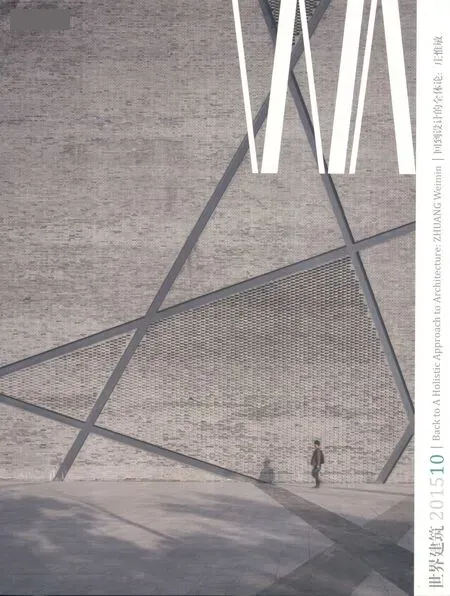东北大学文科2楼,沈阳,中国
东北大学文科2楼,沈阳,中国
Liberal Arts Building #2, Northeastern University, Shenyang, China, 2015
东北大学浑南校区一期建设工程位于浑南新城,距离东北大学总校区(南湖校区)约16km,距离沈阳市中心约18km。浑南校区总用地面积约90.5hm2。文科2楼位于浑南校区西北角,场地北侧为校区东西主干道和风雨操场,东侧为图书馆和校园北广场,西侧为校区南北主干道和室外操场,南侧为校区东西轴线绿化带和文科1楼,均属一期工程建设内容。本项目区四周均为校园道路,距离校园东门和北门较近,交通便利。
项目坚持“以人为本”“可持续发展”和发扬地域特色的原则。体现在建筑设计的理念上,即:从人的角度出发、考虑人的行为模式,以人的视点进行设计,创造宜人的工作学习环境。合理的空间布局、混合功能和流线设计都能给建筑的持续发展创造条件。环境的优化治理、建筑新技术和新材料的合理选择等都能给建筑带来显著的生态效益。在建筑设计中,综合考虑地域在气候、人文、自然环境等方面的特色。同时从东北大学深厚的历史文化底蕴出发,力求使历史与现代呼应,形成完美契合。
文科2楼处于校园核心教学区,是东北大学浑南校区四大学院之一,处于东北大学浑南校区的核心教学区域西北角,与其他三大学院对称布置在校园主轴线和次轴线两侧。校园规划对四大学院有较为严格的控制,合院式平面和立面贴线率,保证四大学院具有相似性,如何在与其他学院融合的情况下突出文科2设计类学院的特色是本设计的关键点。
文科2楼所包含的3个学院属于设计类学院,展示和交流是教学的重要环节。空间的设计应契合设计类学院的日常教学活动,突显学院特质,促进学院文化的形成。同时,文科2楼对东北大学浑南校区的文化氛围具有重要的影响,应作为校园的艺术馆服务于全校师生。
文科2楼项目分为A座(4层)和B座(6层);A座为建筑学院办公及教学用房;B座为文化创意学院及国际交流学院办公及教学用房。文科2楼组团一期由两个回字形建筑组成,在保证相对独立的情况下以廊道相连。两个回字形建筑内部为环廊式交通。在南侧、西侧和东侧设置人行入口,方便师生从北门广场和西南宿舍区方向进入建筑。主要车行流线置于校园道路外环道,本方案在建筑组团的西北角设置停车场,方便教师车辆和后勤车辆到达文科2楼。
本设计在规划严格控制的东北立面采用红砖,再现历史片段,与校园整体氛围调和。在西南立面以混凝土和红砖搭配,增加视觉的丰富性。东北面窗户以自由分布的凸窗为主,体现文科设计类学院的特色。西南面窗户以规律性开窗为主,局部的变化与建筑内部的空间功能相匹配。楔形的穿行道路是此方案的重点空间,两侧以建筑形体和色彩的搭配突显空间的张力和动感,为校园增添活泼的气氛。□

1 总平面/Site plan

2 内景/Interior view

3 草图/Sketch

4 东立面/East facade
Northeast University Hunnan campus phase one is located at Hunnan new town, 16 km from the old campus and 18km from Shenyang downtown. Its site area is approximately 90.5hm2. Located in the campus's northwest corner, the site is bordered by the east-west campus road to the north, the library and plaza to the east, the north-south campus road and playground to the west, and the east-west axial green belt to the south, all of which belonging to phase one. The project is conveniently sited with easy accesses to campus roads and to the east and north gates.
The project adheres to the principles of humanism, sustainability, and regionalism, which are embodied in the design concepts as perspectives on and from human needs and behaviors, so as to create a pleasant environment for work and study. Its reasonable layout, mixeduse program and circulation design can all provide favorable conditions for the building's sustainable development. In addition, the optimization of environment management, reasonable selection of new technology and materials can bring outstanding ecological benefit to the building. The design comprehensively takes into account climatic, human and natural characteristics. Meanwhile, rooted in the rich cultural heritage of Northeastern University, the design aims to present a perfectly integrated image of past and present.
Located at the very heart of the teaching zone, Liberal Arts Building #2 is one of the four schools that constitute the Hunnan campus, disposed symmetrically alongside both main and auxiliary axes. The campus's master plan guidelines have strict control over these schools, aiming to maintain a stylistic similarity through courtyard layout and facade alignment. How to highlight the building's design character while integrating it into the context thus becomes a critical point of the design.
According to the design-oriented nature of the three schools, exhibition and communication form the main units of teaching. Spatial layout should serve these needs and facilitate academic culture. Meanwhile, the building bears strongly on the cultural atmosphere of the Hunnan campus, and therefore should also serve the whole campus community as an art gallery.
the project is divided into two zones: the 4-level zone A consists of architectural school offices and classrooms, and the 6-level zone B belongs to the schools of cultural innovation and international communication. The complex is composed of two rectangular buildings with inner courtyards, connected by galleries while each maintaining its relative independence. Pedestrian entrances are located on the south, west and east sides for easy accesses from the north campus gate and the southwest dorm area. The main driveway is on the outer ring of the campus, while parking lot is conveniently located at the northeast corner of the building complex, providing easy access for faculty and staff.
Due to master plan restrictions, the northeast facade uses red brick so as to re-present historic fragments and adapt to the overall campus atmosphere, while the southwest facade combines red brick with concrete to generate visual diversity. Bay windows are freely disposed on the northeast facade to embody characteristics of a design school. Window openings on the southwest facade follow a general pattern, with local changes to match interior functions. Wedge-shaped paths constitute the crucial space of the design, whose tension and movement is highlighted by the arrangement of building forms and colors. All this adds vitality to the campus.□
项目信息/Credits and Data
项目负责人/Principal in Charge: 庄惟敏/ZHUANG Weimin设计团队/Design Team: 庄惟敏,张维,张红等/ZHUANG Weimin, ZHANG Wei, ZHANG Hong, et al.
场地面积/Site Area: 31,305m2
总建筑面积/Total Floor Area: 28,377m2
建筑高度/Height: 23.98m
设计时间/Design Period: 2011.11-2012.11
竣工时间/Completion: 2015.2
摄影/Photos: 陈尧/CHEN Yao

5 首层平面/Floor 0 plan
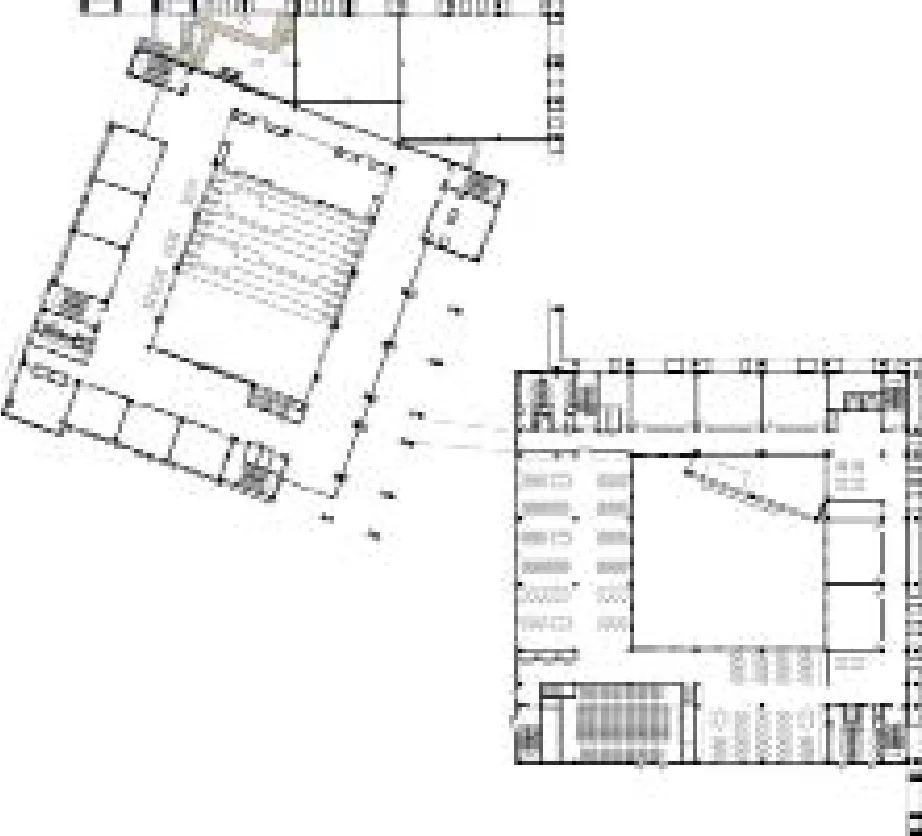
6 二层平面/Floor 1 plan

7 三层平面/Floor 2 plan

9 东侧立面图/East elevation

10.11 B座剖面/Sections of zone B
评论
崔彤:东北大学文科2号楼的设计,在尊重总体规划承袭校园空间秩序的同时,以缜密的思维、婉转的手法,
实现了一种突破性变革,重塑了设计类学院所应有的场所精神。化解“沉闷僵局”的关键在于“转折”,既在原有正交轴线网格中B楼顺时针的转动,形成的楔形空间激活了场地,由此生发出3个空间节点:(1)楔形空间本身作为交往空间整合了A楼和B楼;(2)向南延伸的广场沟通了文科1楼构成开放体系;(3)楔形空间的北尽端,以一种蒙太奇似的转化,暗示出行为路径所引导的“漫步空间”,而耐人寻味的是两个“有顶的梯形院落”与A、B两楼的方形院子(无顶的中庭)的空间嵌套构成一组结构明晰但又生动有趣的公共空间。由此,单体建筑转化为一个学院园区或一个微型城市:一系列的广场、街道、院落、庭园所构成的叙事性空间包容着各种展览、交流、研究活动,教学楼拓展为“博览式教学空间”,从而实现了设计学院的跃迁。在这个看似简约的建筑背后充满着严谨逻辑与复杂经验的辩证统一,在二元对峙中,巧妙地建构了一种动态平衡关系:诸如正交与转轴的逻辑、红砖与混凝土的对比和协调、内院的静谧与边庭的自由开放。更深刻的意义在于:单体建筑获得了类城市群落的品质和趣味;东、西界面深厚庄重的外墙转化为典雅轻盈的空腔;经典的学院形态以中间态影像生成雕切式的语言并依然呈现出古典气质……这一切来自于限制中的突围,源于深思熟虑的驾驭。
Comments
CUI Tong: The design of Northeastern University Liberal Arts Building #2 gives due respect to the principle that its master plan should follow the overall spatial order of the campus. At the same time, with meticulous thoughts and tactful approaches, the design brought about groundbreaking transformation in re-shaping the genius loci that design schools should have. the key point of resolving the "dull impasse" consists in "twists and turns", i.e. the clockwise turn of Building B within its original orthogonal grid system, which forms a stimulating wedge-shaped space with three spatial nodes: 1) the wedge-shaped space itself serves as a communicational space to integrate Buildings A and B; 2) the southward extending square connects to Liberal Arts Building #1 to form an open system; 3) with a montage-like transition, the north end of the wedge-shaped space suggests the "wandering space" guided by behavioral paths; it is intriguing to see the two "roofed trapezoidal courtyards" nesting with the roofless central square courts of Buildings A and B to constitute a series of structurally clear, lively and interesting public spaces.
Individual buildings, therefore, are transformed into a campus park or a micro-urban area: various exhibition, communication and research activities are accommodated in a series of narrative spaces composed of squares, streets and courtyards, while the school building is expanded as an "Expo space" for teaching and learning, thus realizing the design school's transition. Behind this seemingly simple building is the full embodiment of dialectical unity between rigorous logic and complex experience, whose binary confrontation is used skillfully by the designer to create certain dynamic equilibrium, such as the orthogonal and rotational axial logics, the contrast and harmony between red bricks and concrete, the tranquility of inner courts and the openness of side yards, etc. More profoundly, the individual buildings have acquired quasi-urban community tastes and characteristics; the thick, solemn walls of the east and west interfaces are transformed into light, elegant cavities; classic school forms adopt an intermediate imagery to generate an ornate vocabulary while still presenting classical disposition...All these come from breaking through restrictions and are rooted in careful consideration. (English translation by LIU Chen)
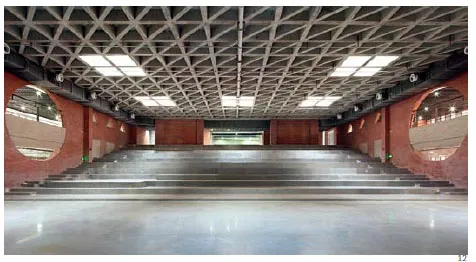
12 报告厅/Lecture hall
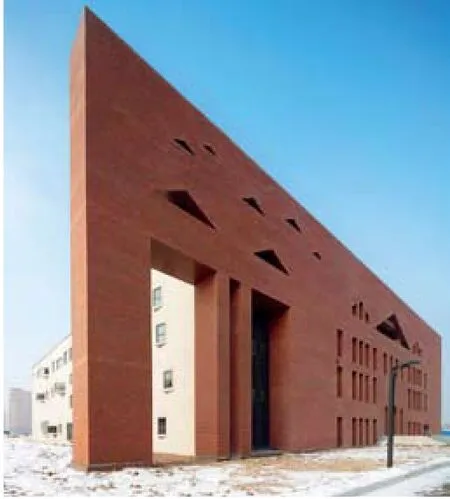
13 东侧外景/East side view

14 流通空间/Flowing space
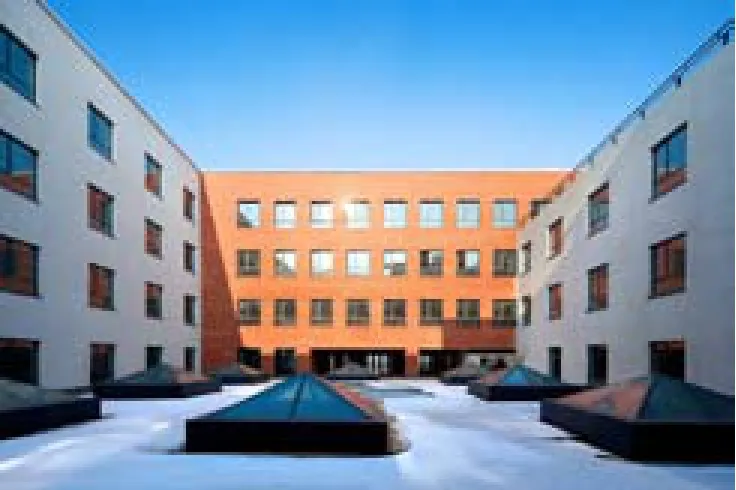
15 B座内院/Inner courtyard of zone B
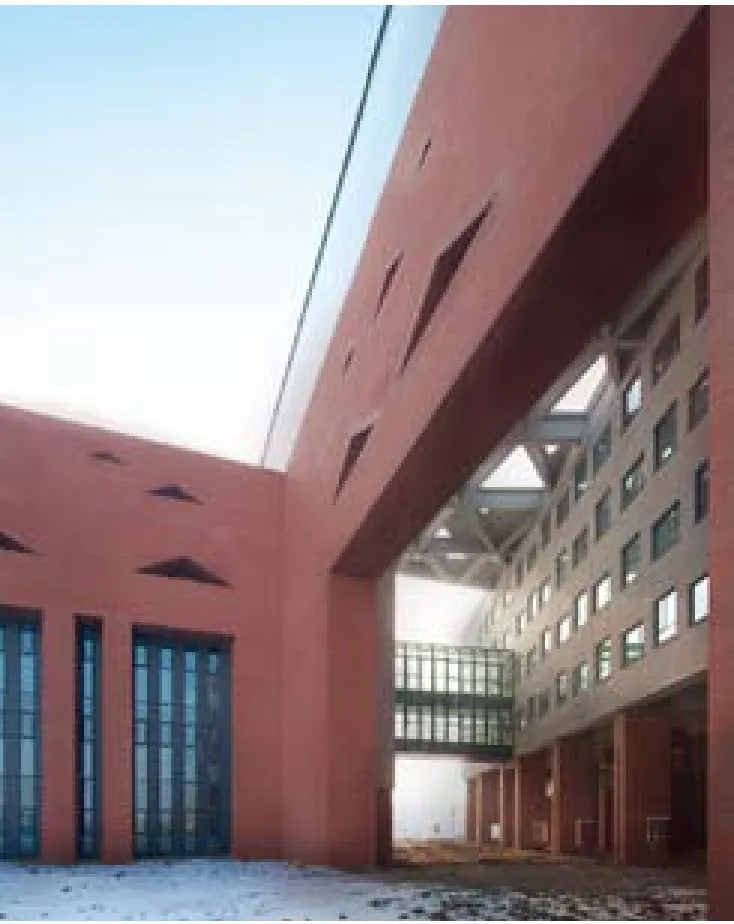
16 西北入口/Northwest entrance

17 交通空间/Area of circulation

